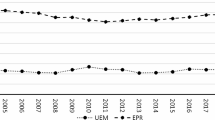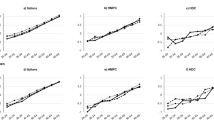Abstract
Purpose
This study explores mortality related to temporary employment, about which very little is known to date.
Methods
In 1996, a health survey was carried out in the French region of Lorraine, and all members of 8,000 randomly chosen households were followed up for mortality over a 13-year period. Mortality of subjects in relation to their employment situation at baseline was analysed using a Cox survival regression.
Results
In comparison with permanent workers, for unemployed men, we found age and occupation-adjusted hazard ratios (HR) of 4.1 for all-causes of death and 3.9 for non-violent causes, and for male temporary workers a HR of 2.2 for both all-causes and non-violent causes of death. Bad health, tobacco smoking and alcohol misuse explained 17 % of the excess risk for the unemployed and 41 % of that for temporary workers.
Conclusion
The observation of large mortality inequalities across the labour market core–periphery structure has important policy implications, particularly in terms of prevention focused on unhealthy behaviours among male unemployed and temporary workers.
Similar content being viewed by others
References
Arulampalam W (2001) Is unemployment really scarring? Effects of unemployment experiences on wages. Econ J 111(November):585–606
Bambra C (2010) Yesterday once more? Unemployment and health in the 21st century. J Epidemiol Commun Health 64:213–215
Banavides F, Benach J, Diez-Roux A, Roman C (2000) How do types of employment relate to health indicators? Findings from the second European survey on working conditions. J Epidemiol Commun Health 54:494–501
Bardasi E, Francesconi M (2004) The impact of atypical employment on individual well-being: evidence from a panel of British workers. Soc Sci Med 58:1671–1688
Bartley M, Ferrie J (2010) Do we need to worry about the health effects of unemployment? J Epidemiol Commun Health 64(1):5–6
Bartley M, Ferrie J, Montgomery SM (1999) Living in a high-unemployment economy: understanding the health consequences. In: Marmot M, Wilkinson RG (eds) Social determinants of health. Oxford University Press, Oxford, pp 81–104
Baumann M et al (2007) Associations of social and material deprivation with tobacco, alcohol, and psychotropic drug use, and gender differentials: a population-based study. Int J Health Geogr 6:50–60
Benach J, Muntaner C (2007) Precarious employment and health: developing a research agenda. J Epidemiol Commun Health 61:276–277
Benach J, Benavides F, Platt S, Diez-Roux A, Muntaner C (2000) The health-damaging potential of new types of flexible employment: a challenge for public health researchers. Am J Public Health 90(8):1316–1317
Benach J, Amable M, Muntaner C, Benavides F (2002) The consequences of flexible work for health: are we looking at the right place? J Epidemiol Commun Health 56:405–406
Beresford T, Blow F, Hill E, Singer K, Lucey M (1990) Comparison of Cage questionnaire and computer-assisted laboratory profiles in screening for covert alcoholism. Lancet 336:482–485
Chau N, Choquet M, Lorhandicap group (2009) Relationship of job demands to initiating smoking in working people: a population-based study. Ind Health 47:319–325
De Cuyper N, Kiran S, De Witte H, Aygoglu F (2008) Associations between temporary employment, alcohol dependence and cigarette smoking among Turkish health care workers. Econ Ind Democr 29:388
De Cuyper N, Notelaers G, De Witte H (2009) Transitioning between temporary and permanent employment: a two-wave study on the entrapment, the stepping stone and the selection hypothesis. J Occup Organ Psychol 82:67–88
DeNavas-Walt C, Proctor B, Smith J, U.S. Census Bureau, Current Population Reports (2011) Income, poverty and health insurance coverage in the United States: 2010. U.S. Government Printing Office, Washington, DC
Goldberg M et al (2001) Socioeconomic, demographic, occupational, and health factors associated with participation in a long-term epidemiologic survey: a prospective study of the French GAZEL cohort and its target population. Am J Epidemiol 154(4):373–384
Gordon D, Edwards R, Reich M (1982) Segmented work, divided workers: the historical transformation of labor in the United States. Cambridge University Press, Cambridge
Hammarstrom A, Janlert U (1994) Unemployment and change of tobacco habits: a study of young-people from 16 to 21 years of age. Addiction 89(12):1691–1696
Iezzoni L, O’Day B (2006) More than ramps. A guide to improving health care quality and access for people with disabilities. Oxford University Press, Oxford
INSEE (2011) Tableaux de l’économie française. INSEE, Paris
Jung Y, Oh J, Huh S, Kawachi I (2013) The effects of employment conditions on smoking status and smoking intensity: the analysis of Korean Labor & Income Panel 8th–10th wave. PLoS ONE 8(2):e57109
Junod B (2006) Le CDD un tremplin vers le CDI dans deux tiers des cas…mais pas pour tous. Paris: DARES, Document d’études No 117
Kivimäki M, Vahtera J, Virtanen M, Elovaino M, Pentti J, Ferrie J (2003) Temporary employment and risk of overall and cause-specific mortality. Am J Epidemiol 158:663–668
Legleye S, Peretti-Watel P, Baumann M, Beck F, Chau N (2011) Gender and age disparities in the association of occupational factors with alcohol abuse and smoking in the French working people. Revue d’Epidémiologie et de Santé Publique 59:223–232
Lemogne C et al (2012) Gender differences in the association between depressive mood and mortality: a 12-year follow-up population-based study. J Affect Disord 136(3):267–275
Lundin A, Lundberg I, Hallsten L, Ottosson J, Hemmingsson T (2010) Unemployment and mortality-a longitudinal prospective study on selection and causation in 49321 Swedish middle-aged men. J Epidemiol Commun Health 64:22–28
Mäki N, Martikainen P (2010) A register-based study on excess suicide mortality among unemployed men and women during different levels of unemployment in Finland. J Epidemiol Commun Health. doi:10.1136/jech.2009.105908
Mesrine A (2000) La surmortalité des chômeurs: un effet catalyseur du chômage? Economie et Statistique 334(4):33–48
Nätti J, Kinnunen U, Mäkikangas A, Mauno S (2009) Type of employment relationship and mortality: prospective study among Finnish employed in 1984–2000. Eur J Pub Health 19(2):150–156
Observatoire des inégalités (2011) Une couverture santé à deux vitesses. In: http://www.inegalites.fr/spip.php?article1450
Petit H (2006) Generalised precariousness or persistent segmentation? In: Köhler C, Junge K, Schröder T, Struck O (eds) Trends in employment stability and labour market segmentation. Jena and Halle: Sonderforschungsbereich Gesellschaftliche Entwicklungen nach dem Systemumbruch - Diskontinuität, Tradition und Strukturbildung, pp 33–40
Quesnel-Vallée A, DeHaney S, Ciampi A (2010) Temporary work and depressive symptoms: a propensity score analysis. Soc Sci Med 70:1982–1987
Roelfs D, Shor E, Davidson K, Schwartz J (2011) Losing life and livelihood: a systematic review and meta-analysis of unemployment and all-cause mortality. Soc Sci Med 72:840–854
Thirion B, Schmitt A (2010) L’emploi en Lorraine: tertiarisation par désindustrialisation, forte poussée des femmes et des seniors. Economie Lorraine 207:1–6
van Beljouwe I, Verhaak P, Prins M, Cuijpers P, Penninx B, Bensing J (2010) Reasons and determinants for not receiving treatment for common mental disorders. Psychiatr Serv 61:250–257
Virtanen M, Kivimäki M, Elovainio M, Vahtera J (2002) Selection from fixed term to permanent employment: prospective study on health, job satisfaction, and behavioural risks. J Epidemiol Commun Health 56:693–699
Virtanen P, Liukkonen V, Vahtera J, Kivimäki M, Koskenvuo M (2003) Health inequalities in the workforce: the labour market core-periphery structure. Int J Epidemiol 32:1015–1021
Virtanen M, Kivimäki M, Joensuu M, Virtanen P, Elovainio M, Vahtera J (2005) Temporary employment and health: a review. Int J Epidemiol 34(3):610–622
Virtanen M et al (2006) Sickness absence as a risk factor for job termination, unemployment, and disability pension among temporary and permanent employees. Occup Environ Med 63:212–217
Waenerlund A, Gustafsson P, Virtanen P, Hammarström A (2011) Is the core-periphery labour market structure related to perceived health? Findings of the Northern Swedish Cohort. BMC Public Health 11:956
Acknowledgments
Lorhandicap study group: N. Chau, F. Guillemin, J.-F. Ravaud, J. Sanchez, S. Guillaume, J.P. Michaely, C. Otero Sierra, B. Legras, A. Dazord, M. Choquet, L. Méjean, N. Tubiana-Rufi, J. P. Meyer, Y. Schléret and J. M. Mur. The authors would like to thank D. Saouag, M. Weiss, M. Depesme-Cuny and B. Phélut for their help during the survey. The work was supported by a Grant from the Pôle Européen de Santé.
Conflict of interest
The authors declare that they have no conflict of interest.
Author information
Authors and Affiliations
Consortia
Corresponding author
Appendix
Appendix
See Table 4.
Rights and permissions
About this article
Cite this article
Khlat, M., Legleye, S., Falissard, B. et al. Mortality gradient across the labour market core–periphery structure: a 13-year mortality follow-up study in north-eastern France. Int Arch Occup Environ Health 87, 725–733 (2014). https://doi.org/10.1007/s00420-013-0915-4
Received:
Accepted:
Published:
Issue Date:
DOI: https://doi.org/10.1007/s00420-013-0915-4




